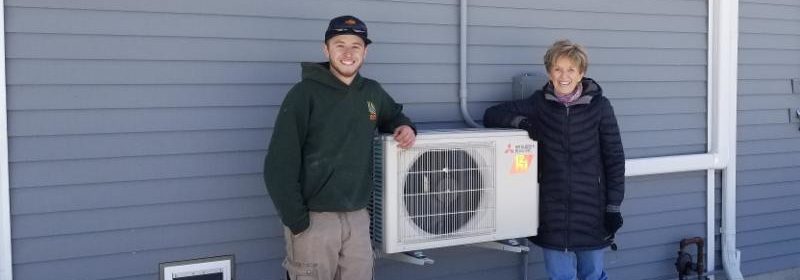

Many Vermonters and most in the Northeast have their own method to the madness of trying to prolong the time before the resumption of those pesky energy bills. If you have a furnace, do you wait to use it until your fingers and toes turn blue? Do you have a sneaky teenager who thinks no one will notice if they turn it up to 80 degrees like I used to? My dad eventually had to put a nail under the temperature gauge inside the thermostat so that it sat at 67 all the time and I couldn’t move it in any direction except down. That was HIS way of saving money and energy.
Some people say that they turn on their furnace 7-10% lower than normal, for a longer period, so that they don’t burn energy when their furnace is working hard to power up each time it is shut off and turned back on. We know the best idea yet, is to trash the thermostat altogether and look into a cold-weather heat pump! That probably seems a little extreme to some… but here’s some information that might convince you otherwise:

What is the difference between a furnace and a heat pump?
Heat pumps don’t burn fuel like a furnace does. Instead, it moves heat from the outdoors into your home in the winter.
How does that make any sense?
Heat pumps do work when it’s cold outside. They extract heat out of the air by circulating a refrigerant that is colder than the air outside, allowing the pump to extract even the littlest bit of heat into your home. This does mean that they work harder, but they don’t use any gas, making them the cleanest option for heating and cooling in your home.
If it’s winter outside, there is no hot air anywhere–especially in Vermont!
This is confusing!
Okay, here is a less complicated explanation of the process:
Heat pumps work in winter by reversing the flow of refrigerant in their internal loop.

- Remember, the heat pump has an outdoor unit that absorbs heat from the outside air and evaporates the refrigerant.
- The now gaseous refrigerant is compressed, raising its temperature.
- The heated refrigerant releases heat inside your home, warming the air.
Heat pumps can keep your home warm even in bone-chilling cold, using far less energy than other heating systems. They are an important tool for energy efficiency and can work as a home’s main heating system in almost any climate!

How do I get started?
Contact us to arrange for a free site visit from one of our experienced heat pump sales managers, so you can get a proposal for our in-house heat pump installation crew to install the system for you. Moving forward, you will enjoy carbon-free comfort, while doing your part to help our fight against climate change!